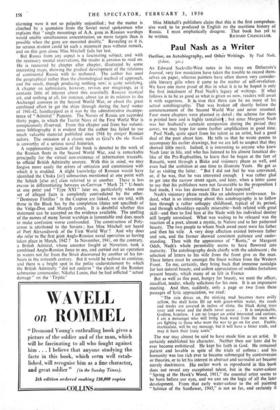Paul Nash as a Writer
As Edward Sackville-West notes in his essay on Delacroix's Journal, very few musicians have taken the trouble to record them- selves on paper, whereas painters have often shown very consider- able literary gifts when it came to the matter of self-revelation. We have one more proof of this in what it is to be hoped is only the first instalment of Paul Nash's legacy of writings. If what follows is to be as good as what is given us now, readers will await it with eagerness. It is...true that there can be no more of his actual autobiography.- That was broken off shortly before the commencement of the Second World War and never resumed. Four more chapters were planned in detail ; the scheme for them is printed here and is highly tantalisini ; but since Margaret Nash was her husband's constant companion during the period they cover, we may hope for some further amplification in good time.
Paul Nash, quite apart from his talent as an artist, had a good deal of the poet about him. He tells us that he wrote poems to accompany his earlier drawings, but we are left to suspect that they showed little merit. Indeed, it is interesting to anyone who knew Nash later in life, and who has listened to his almost fanatical dis- like of the Pre-Raphaelites, to learn that he began at the feet of Rossetti, went through a Blake and visionary phase as well, and even had the ambition at one time to illustrate Yeats. He got as far as visiting the latter. "But I did not feel he was convinced, or, if he was, that he was interested enough. I was rather glad to get into the narrow street again, and later, when a letter came to say that his publishers were not favourable to the proposition I had made, I was less downcast than I had expected."
Nash's visionary phase reads like an adolescent irrelevance. In- deed, what is so interesting about this autobiography is to follow him through a rather unhappy childhood, typical of its period, and through schooldays equally miserable—both related with great skill—and then to find him at the Slade with his individual destiny still largely unrealised. What was waiting to be released was the reaction of a poet, almost a mystic, to Nature and to her patterned beauty. The two people to whom Nash owed most were his father and then his wife. A very deep affection existed between father and son, and the former showed consistent patience and under- standing. Then with the appearance of " Bunty," or Margaret Odeh, Nash's whole personality seems to have flowered into maturity. The autobiography deals chiefly with the adolescent ; the selection of letters to his wife from the front give us the man. These letters must be amongst the finest written from the Western Front. To me, certainly, they bring back that immense nostalgia for lost natural beauty, and ardent appreciation of sudden fortuitous present beauty, which many of us felt in France.
But as well as this poet, hungry for beauty, we meet the officer, steadfast, tender, wholly solicitous for his men. It is an impressive meeting. And then, suddenly, only a page or two from these passages of lyric appreciation, we read: "The rain drives on, the stinking mud becomes more evilly yellow, the shell holes fill up with green-white water, the roads and tracks are covered in inches of slime, the black dying trees ooze and sweat and the shells never cease. . . It is unspeakable, Godless, hopeless. I am no longer an artist interested and curious, I am a messenger who will bring back word from the men who are fighting to those who want the war to go on for ever. Feeble, inarticulate, will be my message, but it will have a bitter truth, and may it burn their lousy souls."
The war may almost be said to have made him as an artist. It certainly established his character. Neither then nor later did he ever become embittered. He kept his faith in God. He remained patient and lovable in spite of the trials of asthma ; and his humanity was too rich.eVer to become submerged by controversies or theories, or to let his interest in abstract and surrealist art become merely doctrinaire. His earlier work as reproduced in this book does not reveal any exceptional talent, but in the water-colour "Spring at the Hawk's Wood, 1911," the essential artist seems to be born before our eyes, and we can see the logic of all the later development. From that early water-colour to the oil painting "Solstice of the Sunflower, 1945," is not so far, and certainly it involves no radical change of direction. Five of these essays, from The Architectural Review and elsewhere, are reprinted in this book, and indicate Nash's orientation to certain phrases and to certain trends in art. They are as charming and as lucid as his conversa- tion. Though they may have seemed controversial at the time, they read genially enough now. Indeed, the whole volume has been so skilfully arranged that we are hardly aware that the material has been assembled from a number of different sources ; rather we feel ourselves throughout in the presence of a unity, of an integrated personality, of a lovable and remarkable man. MONK GIBBON.



































 Previous page
Previous page